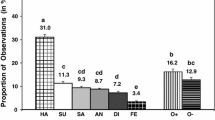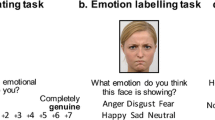Abstract
This article is a methodological note on a potential problem with a forced-choice response scale in the study of facial expressions of emotion. For example, a majority of subjects categorized Matsumoto and Ekman's (1988) reported facial expression of “anger” as contempt when using one forced-choice format, as disgust, with another format, and as frustration, with a third. When shown the anger expression and given a choice amonganger, frustration, and other labels, few subjects (12.5% on average) selectedanger. Ifcontempt, digust, andfrustration are considered wrong answers, then forced choice can yield consensus on the wrong answer; ifanger is the right answer, then forced choice can fail to yield consensus on the right answer.
Similar content being viewed by others
References
Boucher, J. D., & Carlson, G. E. (1980). Recognition of facial expression in three cultures.Journal of Cross-Cultural Psychology, II, 263–280.
Ekman, P. (1972). Universal and cultural differences in facial expressions of emotions. In J. K. Cole (Ed.),Nebraska Symposium on Motivation, 1971 (pp. 207–283). Lincoln: University of Nebraska Press.
Ekman, P., & Friesen, W. V. (1971). Constants across cultures in the face and emotion.Journal of Personality and Social Psychology, 17, 124–129.
Ekman, P., & Friesen, W. V. (1975).Unmasking the face. Englewood Cliffs, NJ: Prentice-Hall.
Ekman, P., & Friesen, W. V. (1986). A new pan-cultural facial expression of emotion.Motivation and Emotion, 10, 159–168.
Ekman, P., & Friesen, W. V. (1988). Who knows what about contempt: A reply to Izard and Haynes.Motivation and Emotion, 12, 17–22.
Ekman, P., Friesen, W. V., O'Sullivan, M., Chan, A., Diacoyanni-Tarlatzis, I., Heider, K., Krause, R., LeCompte, W. A., Pitcairn, T., Ricci-Bitti, P. E., Scherer, K., Tomita, M., & Tzavaras, A. (1987). Universals and cultural differences in the judgments of facial expressions of emotion.Journal of Personality and Social Psychology, 53, 712–717.
Ekman, P., & Heider, K. G. (1988). The universality of a contempt expression: A replication.Motivation and Emotion, 12, 303–308.
Ekman, P., O'Sullivan, M., & Matsumoto, D. (1991). Contradictions in the study of contempt: What's it all about?Motivation and Emotion, 15, 293–296.
Ekman, P., Sorenson, E. R., & Friesen, W. V. (1969). Pan-cultural elements in the facial displays of emotions.Science, 164, 86–88.
Frijda, N. H. (1953). The understanding of facial expression of emotion.Acta Psychologica, 9, 294–362.
Izard, C. E. (1971).The face of emotion. New York: Appleton Century Crofts.
Johnson-Laird, P. N., & Oatley, K. (1989). The language of emotions: An analysis of a semantic field.Cognition and Emotion, 3, 81–123.
Matsumoto, D., & Ekman, P. (1988). Japanese and Caucasian Facial Expressions of Emotion (JACFEE). Slide set and brochure available from first author, San Francisco State University.
McAndrew, F. T. (1986). A cross-cultural study of recognition thresholds for facial expression of emotion.Journal of Cross-Cultural Psychology, 17, 211–224.
Niit, T., & Valsiner, J. (1977). Recognition of facial expressions: An experimental investigation of Ekman's model.Acta et Commentationes Universitatis Tarvensis, 429, 85–107.
Russell, J. A. (1989). Measures of emotion. In R. Plutchik & H. Kellerman (Eds.),Emotion: Theory, research and experience (Vol. 4, pp. 83–111). New York: Academic Press.
Russell, J. A., & Bullock, M. (1986). Fuzzy concepts and the perception of emotion in facial expressions.Social Cognition, 4, 309–341.
Russell, J. A., & Fehr, B. (1987). Relativity in the perception of emotion in facial expressions.Journal of Experimental Psychology: General, 116, 223–237.
Sorenson, E. R. (1975). Culture and the expression of emotion. In T. R. Williams (Ed.),Psychological anthropology (pp. 361–372). Chicago: Aldine.
Author information
Authors and Affiliations
Additional information
This study was funded by a grant from the Social Sciences and Humanities Research Council of Canada.
I thank Dee-Ann Matsugu, Lara Weick, and Lisa Wong for their work on this study.
Rights and permissions
About this article
Cite this article
Russell, J.A. Forced-choice response format in the study of facial expression. Motiv Emot 17, 41–51 (1993). https://doi.org/10.1007/BF00995206
Issue Date:
DOI: https://doi.org/10.1007/BF00995206




